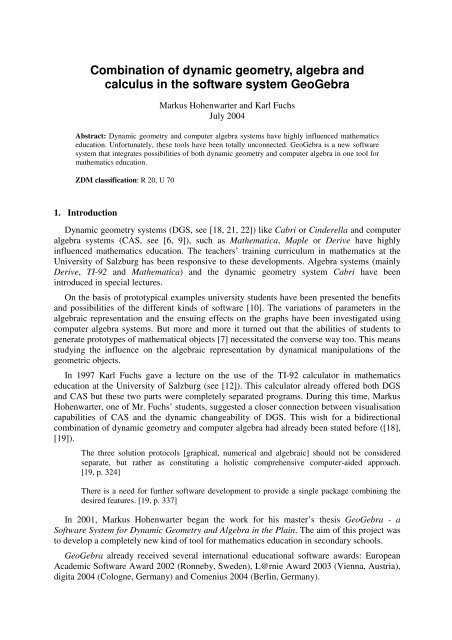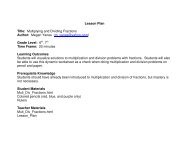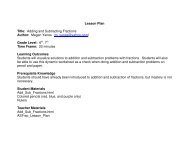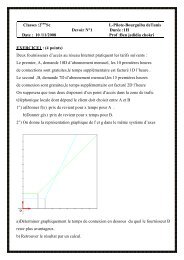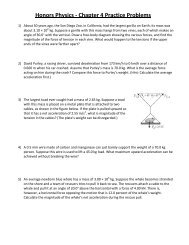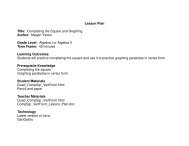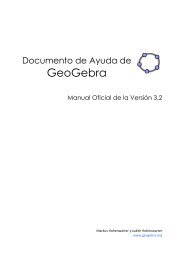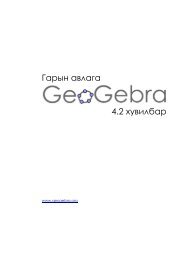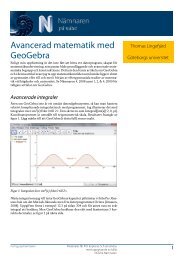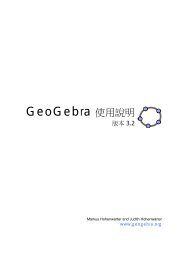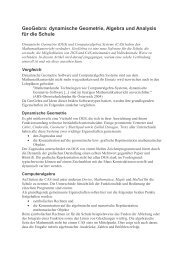Combination of dynamic geometry, algebra and calculus - GeoGebra
Combination of dynamic geometry, algebra and calculus - GeoGebra
Combination of dynamic geometry, algebra and calculus - GeoGebra
- No tags were found...
You also want an ePaper? Increase the reach of your titles
YUMPU automatically turns print PDFs into web optimized ePapers that Google loves.
<strong>Combination</strong> <strong>of</strong> <strong>dynamic</strong> <strong>geometry</strong>, <strong>algebra</strong> <strong>and</strong><br />
<strong>calculus</strong> in the s<strong>of</strong>tware system <strong>GeoGebra</strong><br />
Markus Hohenwarter <strong>and</strong> Karl Fuchs<br />
July 2004<br />
Abstract: Dynamic <strong>geometry</strong> <strong>and</strong> computer <strong>algebra</strong> systems have highly influenced mathematics<br />
education. Unfortunately, these tools have been totally unconnected. <strong>GeoGebra</strong> is a new s<strong>of</strong>tware<br />
system that integrates possibilities <strong>of</strong> both <strong>dynamic</strong> <strong>geometry</strong> <strong>and</strong> computer <strong>algebra</strong> in one tool for<br />
mathematics education.<br />
ZDM classification: R 20, U 70<br />
1. Introduction<br />
Dynamic <strong>geometry</strong> systems (DGS, see [18, 21, 22]) like Cabri or Cinderella <strong>and</strong> computer<br />
<strong>algebra</strong> systems (CAS, see [6, 9]), such as Mathematica, Maple or Derive have highly<br />
influenced mathematics education. The teachers’ training curriculum in mathematics at the<br />
University <strong>of</strong> Salzburg has been responsive to these developments. Algebra systems (mainly<br />
Derive, TI-92 <strong>and</strong> Mathematica) <strong>and</strong> the <strong>dynamic</strong> <strong>geometry</strong> system Cabri have been<br />
introduced in special lectures.<br />
On the basis <strong>of</strong> prototypical examples university students have been presented the benefits<br />
<strong>and</strong> possibilities <strong>of</strong> the different kinds <strong>of</strong> s<strong>of</strong>tware [10]. The variations <strong>of</strong> parameters in the<br />
<strong>algebra</strong>ic representation <strong>and</strong> the ensuing effects on the graphs have been investigated using<br />
computer <strong>algebra</strong> systems. But more <strong>and</strong> more it turned out that the abilities <strong>of</strong> students to<br />
generate prototypes <strong>of</strong> mathematical objects [7] necessitated the converse way too. This means<br />
studying the influence on the <strong>algebra</strong>ic representation by <strong>dynamic</strong>al manipulations <strong>of</strong> the<br />
geometric objects.<br />
In 1997 Karl Fuchs gave a lecture on the use <strong>of</strong> the TI-92 calculator in mathematics<br />
education at the University <strong>of</strong> Salzburg (see [12]). This calculator already <strong>of</strong>fered both DGS<br />
<strong>and</strong> CAS but these two parts were completely separated programs. During this time, Markus<br />
Hohenwarter, one <strong>of</strong> Mr. Fuchs’ students, suggested a closer connection between visualisation<br />
capabilities <strong>of</strong> CAS <strong>and</strong> the <strong>dynamic</strong> changeability <strong>of</strong> DGS. This wish for a bidirectional<br />
combination <strong>of</strong> <strong>dynamic</strong> <strong>geometry</strong> <strong>and</strong> computer <strong>algebra</strong> had already been stated before ([18],<br />
[19]).<br />
The three solution protocols [graphical, numerical <strong>and</strong> <strong>algebra</strong>ic] should not be considered<br />
separate, but rather as constituting a holistic comprehensive computer-aided approach.<br />
[19, p. 324]<br />
There is a need for further s<strong>of</strong>tware development to provide a single package combining the<br />
desired features. [19, p. 337]<br />
In 2001, Markus Hohenwarter began the work for his master’s thesis <strong>GeoGebra</strong> - a<br />
S<strong>of</strong>tware System for Dynamic Geometry <strong>and</strong> Algebra in the Plain. The aim <strong>of</strong> this project was<br />
to develop a completely new kind <strong>of</strong> tool for mathematics education in secondary schools.<br />
<strong>GeoGebra</strong> already received several international educational s<strong>of</strong>tware awards: European<br />
Academic S<strong>of</strong>tware Award 2002 (Ronneby, Sweden), L@rnie Award 2003 (Vienna, Austria),<br />
digita 2004 (Cologne, Germany) <strong>and</strong> Comenius 2004 (Berlin, Germany).
M. Hohenwarter <strong>and</strong> K. Fuchs<br />
2. What is <strong>GeoGebra</strong>?<br />
<strong>GeoGebra</strong> is an interactive <strong>geometry</strong> s<strong>of</strong>tware [13, 14] that also <strong>of</strong>fers <strong>algebra</strong>ic<br />
possibilities like entering equations directly. It is aimed at students (aged 10 to 18) <strong>and</strong><br />
teachers in secondary schools. The program encourages students to approach mathematics in<br />
an experimental way. For example, it is possible to investigate the parameters <strong>of</strong> a circle’s<br />
equation by dragging the circle with the mouse. On the other h<strong>and</strong>, students may also<br />
manipulate the equation directly <strong>and</strong> see the changed circle in the <strong>geometry</strong> window.<br />
Figure 1. Circle with tangents<br />
The interactive construction protocol is indeed significant. Already Bender <strong>and</strong> Schreiber<br />
pointed out that the description <strong>of</strong> a geometric construction is the pretheoretical basis for the<br />
idea <strong>of</strong> an algorithm [3]. The construction protocol <strong>of</strong> <strong>GeoGebra</strong> makes it possible to redo<br />
constructions at any time, insert new elements <strong>and</strong> even change its order with hindsight.<br />
Whenever students are entering or deleting expressions they must be aware <strong>of</strong> functional<br />
dependencies [23].<br />
3. What does <strong>GeoGebra</strong> <strong>of</strong>fer?<br />
The basic objects in <strong>GeoGebra</strong> are points, vectors, segments, polygons, straight lines, all<br />
conic sections <strong>and</strong> functions in x. With <strong>GeoGebra</strong> <strong>dynamic</strong> constructions can be done like in<br />
any other <strong>dynamic</strong> <strong>geometry</strong> system. These constructions may be altered <strong>dynamic</strong>ally by<br />
dragging free objects. Furthermore, it is possible to enter coordinates <strong>of</strong> points or vectors,<br />
equations <strong>of</strong> lines, conic sections or functions <strong>and</strong> numbers or angles directly.<br />
Hence, from the very beginning the s<strong>of</strong>tware has been designed for the use in schools. The<br />
treatment <strong>of</strong> problems should not be affected by system-caused translations. Manipulations<br />
ought to be possible in a familiar way [5]. Big efforts have been made to allow input in school<br />
notation: For example a line g may be entered as g: 3x + 4y = 7 or a circle c as c: (x - 3) 2 + (y<br />
+ 2) 2 = 25.<br />
2
<strong>Combination</strong> <strong>of</strong> <strong>dynamic</strong> <strong>geometry</strong>, <strong>algebra</strong> <strong>and</strong> <strong>calculus</strong><br />
Also, calculations with geometric objects like points <strong>and</strong> vectors are feasible. The centroid<br />
<strong>of</strong> a triangle with vertices A, B <strong>and</strong> C might be entered as S = (A + B + C) / 3. Additionally,<br />
<strong>GeoGebra</strong> <strong>of</strong>fers many powerful comm<strong>and</strong>s starting from the slope <strong>of</strong> a straight line up to<br />
differentiation <strong>and</strong> integration <strong>of</strong> functions.<br />
<strong>GeoGebra</strong> is multilingual not only in its menus but also in its comm<strong>and</strong>s. For example, the<br />
English comm<strong>and</strong> Intersect becomes Schneide in German <strong>and</strong> Interseccíon in Spanish.<br />
4. Applications in Schools<br />
<strong>GeoGebra</strong> is a very versatile tool for mathematics education in secondary schools. In<br />
teaching mathematics it might be used in many different ways.<br />
1. <strong>GeoGebra</strong> for demonstration <strong>and</strong> visualisation<br />
Even in traditional teaching, computer s<strong>of</strong>tware has its status. In his discussion about<br />
the role <strong>of</strong> specific s<strong>of</strong>tware Becker [2] mentions the aspect <strong>of</strong> specific s<strong>of</strong>tware as a<br />
tool for demonstration <strong>and</strong> visualisation. In this sense, <strong>GeoGebra</strong> is a s<strong>of</strong>tware with a<br />
wide coverage due to its different representations.<br />
2. <strong>GeoGebra</strong> - a construction tool<br />
In 1990 Karl Fuchs [8] pointed out the importance <strong>of</strong> computer aided drawing /<br />
designing systems for teaching constructive <strong>geometry</strong> at the state <strong>of</strong> the art. Not<br />
substitution <strong>of</strong> traditional but integration <strong>of</strong> new methods was intended by him. The<br />
idea <strong>of</strong> ‘computer utilisation’ became fundamental. <strong>GeoGebra</strong> has all the abilities<br />
which are dem<strong>and</strong>ed from a suitable drawing / designing s<strong>of</strong>tware [3].<br />
3. <strong>GeoGebra</strong> <strong>and</strong> discovering mathematics<br />
Computers <strong>and</strong> mathematical s<strong>of</strong>tware have provoked new basic questions on teaching<br />
mathematics. Students can organize knowledge on their own. For example, Artigue <strong>and</strong><br />
Lagrange [1] are reporting on the positive influence <strong>of</strong> computer <strong>algebra</strong> systems on<br />
teaching mathematics. This experimental form is added to the traditional form <strong>of</strong><br />
teacher concentrated education as described in item 1 above. <strong>GeoGebra</strong> can be used as<br />
an important tool for this challenge. It can help to create a suitable atmosphere for<br />
learning (compare with [17]).<br />
4. <strong>GeoGebra</strong> for preparing teaching materials<br />
<strong>GeoGebra</strong> encourages teachers to prepare materials for the teaching process using it as<br />
a cooperation-, communication- <strong>and</strong> representation tool. This follows Kerres’ ideas <strong>of</strong><br />
the educational functions <strong>of</strong> new media [15].<br />
The s<strong>of</strong>tware can be used with students aged 10 to 18, beginning with simple constructions<br />
up to the integration <strong>of</strong> functions. No matter if students explore mathematics alone or in<br />
groups, the teacher should try to be an advisor in the background who gives support when help<br />
is needed. The students’ results <strong>of</strong> their experiments with <strong>GeoGebra</strong> should be the basis for<br />
discussions in class. This gives teachers more time to concentrate on fundamental ideas <strong>and</strong><br />
mathematical reasoning [20].<br />
The following example shows a <strong>dynamic</strong> worksheet where students can discover the<br />
function <strong>of</strong> the slope <strong>of</strong> a parabola themselves. They see an arbitrary point T on the graph, the<br />
tangent t through this point <strong>and</strong> its slope k. Now we investigate another point (x T , k) with the<br />
x-coordinate <strong>of</strong> T <strong>and</strong> the corresponding slope k as its y-coordinate. By dragging the point T<br />
along the graph <strong>of</strong> the parabola, a trace <strong>of</strong> the slope function is generated experimentally.<br />
3
M. Hohenwarter <strong>and</strong> K. Fuchs<br />
Now, the students should try to read <strong>of</strong>f the equation <strong>of</strong> the slope function using the coordinate<br />
grid. By plotting this equation with <strong>GeoGebra</strong> they can verify their assumption easily.<br />
Figure 2. Slope function <strong>of</strong> x 2 /6 – 2x + 8<br />
This is a motivating example for the geometric model <strong>of</strong> the first derivative. Here, the<br />
tangent is used as a black box [11, p.57] providing a basis for the discussion <strong>of</strong> the tangent line<br />
problem afterwards.<br />
5. Dynamic Worksheets<br />
With <strong>GeoGebra</strong> it is possible to create interactive HTML pages – so called <strong>dynamic</strong><br />
worksheets – which can be used with any Internet browser that supports Java (e.g. Internet<br />
Explorer, Mozilla, Netscape). These worksheets are totally independent from the program<br />
itself, i.e. <strong>GeoGebra</strong> does not have to be installed to use the worksheet. Thus, <strong>GeoGebra</strong> is<br />
also a tool to create interactive e-learning content.<br />
The st<strong>and</strong>-alone application can be used on any platform (MS Windows, Unix, Linux,<br />
MacOS) <strong>and</strong> <strong>GeoGebra</strong> may even be started directly from the Internet eliminating complicated<br />
installation or upgrade procedures which is especially useful for computer networks in<br />
schools.<br />
6. Behind the Scenes<br />
<strong>GeoGebra</strong> is based on projective <strong>and</strong> Euclidian <strong>geometry</strong> in the real plane. Equations are<br />
exp<strong>and</strong>ed <strong>and</strong> simplified symbolically <strong>and</strong> a special grammar for arithmetical expressions in<br />
school notation has been implemented. In most <strong>dynamic</strong> <strong>geometry</strong> systems you will encounter<br />
jumping objects in certain constructions. For example, the intersection points <strong>of</strong> two conic<br />
sections may permutate wildly in Cabri when an ellipse becomes a hyperbola. In <strong>GeoGebra</strong><br />
this continuity problem [16, pp.84] is tackled by a sophisticated heuristic approach [13,<br />
pp.163] eliminating jumping objects.<br />
For the differentiation <strong>and</strong> integration <strong>of</strong> functions in one variable the open source<br />
computer <strong>algebra</strong> system JSCL is built into <strong>GeoGebra</strong>.<br />
4
<strong>Combination</strong> <strong>of</strong> <strong>dynamic</strong> <strong>geometry</strong>, <strong>algebra</strong> <strong>and</strong> <strong>calculus</strong><br />
7. Future Aspects<br />
The development <strong>of</strong> <strong>GeoGebra</strong> by Markus Hohenwarter is going on rapidly in the course <strong>of</strong><br />
his PhD thesis <strong>GeoGebra</strong> - Development <strong>of</strong> Educational Material <strong>and</strong> Applications in<br />
Mathematics Teaching. Some <strong>of</strong> the planned features are:<br />
• intersection <strong>of</strong> functions, function – line<br />
• root finding <strong>of</strong> arbitrary functions, local minimum / maximum, turning point<br />
• locus lines<br />
• automatic animations<br />
• macros<br />
The free s<strong>of</strong>tware <strong>and</strong> further information can be found on the <strong>GeoGebra</strong> website on the<br />
Internet http://www.geogebra.at.<br />
References<br />
[1] Michele Artigue <strong>and</strong> Jean-Baptiste Lagrange. Pupils learning <strong>algebra</strong> with Derive - a<br />
didactic perspective. Zentralblatt für Didaktik der Mathematik, 4:105–112, 1997.<br />
[2] Gerold Becker. Die ‘neuen’ Medien im Unterricht. Computer und Unterricht, (37):11–<br />
13, 2000.<br />
[3] Peter Bender <strong>and</strong> Alfred Schreiber. Operative Genese der Geometrie. Number 12. hpt,<br />
1985.<br />
[4] Arbeitsgruppe BMUK. Neue Techniken im Geometrischen Zeichnen, volume III.<br />
Bundesministerium für Unterricht und Kunst, 1991.<br />
[5] Bruno Buchberger <strong>and</strong> Tudor Jebelean. Teaching <strong>of</strong> Mathematics using Theorema.<br />
International Journal <strong>of</strong> Computer Algebra in Mathematics Education, (6):25–50, 1999.<br />
[6] J. H. Davenport. Computer <strong>algebra</strong> - past, present <strong>and</strong> future. Euromath Bulletin,<br />
1(2):25–44, 1994.<br />
[7] W. Dörfler. Der Computer als kognitives Werkzeug und kognitives Medium. In:<br />
Schriftenreihe Didaktik der Mathematik, volume 21, pages 51–75. hpt, Wien, 1991.<br />
[8] Karl Fuchs. Computer im Geometrisch-Zeichenunterricht - Integrieren statt Ersetzen.<br />
Informationsblätter für Darstellende Geometrie, 1:1–4, 1990.<br />
[9] Karl Fuchs. Computer<strong>algebra</strong>systeme im Unterricht - Einige konkrete Beispiele.<br />
Didaktik der Mathematik, 3:228–238, 1995.<br />
[10] Karl Fuchs. Computer im Mathematikunterricht - Erfahrungen und Gedanken.<br />
Didaktikhefte der ¨OMG, (26):21–35, 1997.<br />
[11] Karl Fuchs. Computer<strong>algebra</strong> - Neue Perspektiven im Mathematikunterricht. University<br />
<strong>of</strong> Salzburg, 1998.<br />
[12] Markus Hohenwarter. Komplexe Zahlen zum Anfassen. TI-Nachrichten, (2):16–17,<br />
1998.<br />
[13] Markus Hohenwarter. <strong>GeoGebra</strong> - ein S<strong>of</strong>twaresystem für dynamische Geometrie und<br />
Algebra der Ebene. Master’s thesis, Universität Salzburg, 2002.<br />
[14] Markus Hohenwarter. <strong>GeoGebra</strong> - dynamische Geometrie und Algebra der Ebene. Der<br />
Mathematikunterricht, (4):33–40, 2003.<br />
[15] Michael Kerres. Mediendidaktische Analyse digitaler Medien im Unterricht. Computer<br />
und Unterricht, (37):26–28, 2000.<br />
5
M. Hohenwarter <strong>and</strong> K. Fuchs<br />
[16] Ulrich Kortenkamp. Foundations <strong>of</strong> Dynamic Geometry. PhD thesis, Swiss Federal<br />
Institute <strong>of</strong> Technology Zurich, 1999.<br />
[17] Edith Schneider. Veränderungen der Lern- und Unterrichtskultur im<br />
computerunterstützten Mathematikunterricht. In: Integrativer Unterricht in Mathematik,<br />
Abakus, Salzburg, 1997.<br />
[18] Heinz Schumann. Schulgeometrisches Konstruieren mit dem Computer. Teubner und<br />
Metzler, Stuttgart, 1991. www.mathe-schumann.de.<br />
[19] Heinz Schumann <strong>and</strong> David Green. New protocols for solving geometric calculation<br />
problems incorporating <strong>dynamic</strong> <strong>geometry</strong> <strong>and</strong> computer <strong>algebra</strong> s<strong>of</strong>tware. International<br />
Journal <strong>of</strong> Mathematical Education in Science <strong>and</strong> Technology, 31(3):319–339, 2000.<br />
[20] Fritz Schweiger. Fundamentale Ideen - Eine geistesgeschichtliche Studie. Journal für<br />
Mathematikdidaktik, 2/3:199–214, 1992.<br />
[21] Rudolf Sträßer. Cabri-géomètre: Does a Dynamic Geometry S<strong>of</strong>tware (DGS) Change<br />
Geometry <strong>and</strong> its Teaching <strong>and</strong> Learning? International Journal for Computers in<br />
Mathematics Learning, 3(6):319–333, 2001.<br />
[22] Rudolf Sträßer. Research on Dynamic Geometry S<strong>of</strong>tware (DGS) - an introduction.<br />
Zentralblatt für Didaktik der Mathematik, 3(34):65, 2002.<br />
[23] Hans Joachim Vollrath. Funktionales Denken. Journal für Mathematikdidaktik, 10:3–37,<br />
1989.<br />
___________<br />
Authors<br />
Markus Hohenwarter, University <strong>of</strong> Salzburg, Department <strong>of</strong> Mathematics <strong>and</strong> Computer<br />
Science Education, Hellbrunnerstraße 34, A-5020 Salzburg, Austria; e-mail:<br />
markus.hohenwarter@sbg.ac.at; web: http://www.geogebra.at<br />
Karl Fuchs, University <strong>of</strong> Salzburg, Department <strong>of</strong> Mathematics <strong>and</strong> Computer Science<br />
Education, Hellbrunnerstraße 34, A-5020 Salzburg, Austria; e-mail: karl.fuchs@sbg.ac.at<br />
6


